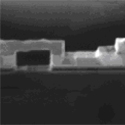Giant magnetoresistance goes electric
Giant magnetoresistance (GMR), the subject of the Nobel Prize in Physics in 2007, has led to technologies such as read-write heads for hard drives, as well as other promising devices that may one day be used for spin-dependent electronic applications (spintronics). An example of the latter is a magnetic heterostructure, called a “spin valve,” consisting of alternating ferromagnetic and nonmagnetic layers, whose resistance can be controlled by magnetism. When a current is passed through these structures, the electrons scatter differently depending on the electron spin, so the resistance of the structure depends on the relative magnetic orientation of the ferromagnetic layers. This resistance is linear and current independent.
In a recent work published in Physical Review Letters, Atif Aziz and Mark Blamire of the University of Cambridge, together with collaborators from Imperial College London and the University of Leeds, all in the UK, study the transport properties of a dual spin valve structure of /permalloy ( . The dual spin valve is in an unconventional configuration in which the outer ferromagnetic layers are antiparallel, canceling the linear magnetoresistance. However, when the spin populations are far from equilibrium, Aziz et al. observe a nonlinear, current-dependent magnetoresistance. While the exact physical mechanism of this nonlinear effect has not been established, the authors attribute the effect to current-dependent interfacial and bulk scattering asymmetries in the permalloy layer. The dual spin valve studied here can, depending on the relative orientations of the magnetic moments, work as a magnetic analog to a Wheatstone bridge, or a diode that is reversible by switching the permalloy moment. – Daniel Ucko





